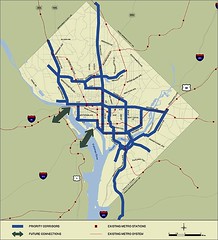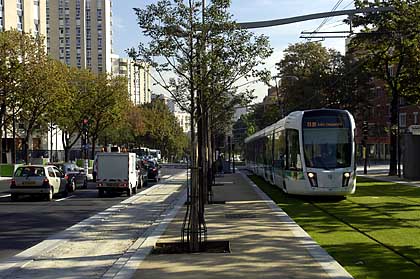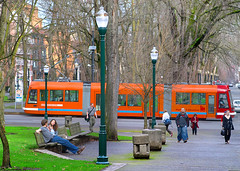We can't take reaching subway capacity for granted. Instead, we have to deal with it now.
Today's Examiner has an article, "Metro looking to update outdated bus garages," with these two scary sentences:
Because the rail system is slated to reach capacity by 2025, Metro officials are trying to bolster the bus system as a way to expand the system’s capacity without building new rail lines. They are trying to create priority bus corridors to help buses weave through traffic-clogged roads and make the system more appealing to wary riders.
I find this very scary, that because of cost, the focus on dealing with reaching capacity on the subway system is adding bus service. It's guaranteed to be a losing game.
In the best case, a 60 foot long articulated bus can carry about 125 people. In the best case, on the red line, an 8 car train can carry over 1,000 people, and can do this at least 30 times each hour, in both directions, for a capacity of 60,000 people/hour (in both directions). (The red line, not sharing tracks with other lines, can run the most trains per hour. On the other lines, switching back and forth between lines by throwing switches limits the maximum capacity to 26 trains/hour total.)
In the city, you can't move 60 foot long buses every two minutes on the city streets because of street capacity limitations. (Note that bus rapid transit systems using dedicated travelways can move at this rate, and with more passengers, depending on the equipment. For a variety of reasons, I think it is difficult if not impossible in the city, except by making some street lanes over into exclusive bus lanes. And to work, they'd have to be like how it is done in Paris, where the bus lanes run against traffic, in order to "encourage" cars to not use the same lane.)
And even if you could, at best that is 3,750 passengers/hour, double that for both directions.
So how is it that adding bus service can significantly address fixed rail capacity issues? Sure, adding streetcars and light rail to surface streets can increase capacity to a significant degree, from 10,000 to 15,000 passengers/hour in each direction.
Buses?
All the more reason to advocate for capacity increases in the core of the system. That means doing things like moving to 4 door trains. It also means adding the "separated blue line" as well as the creation of a robust system of surface-street-based streetcars and light rail.

WMATA's 2001 separated blue line proposal. While the line shows 6 new stations in DC, including service to Georgetown, additional stations could be added between Mount Vernon and Union Station.

DC's more robust streetcar plan from 2004 wasn't perfect because it inadequately considered the need for better connections to Prince George's and Montgomery County in Maryland, even as it proposed two connections to Virginia, and didn't distinguish between higher demand/regional lines using light rail (such as what is being planned for the Purple Line in Maryland) vs. streetcars. This plan was scuttled in favor of a less robust proposal.

Paris light rail (tram) is integrated into the urban fabric, and can carry upwards of 15,000 passengers per hour in each direction, depending on the number of vehicles in a train set.

A typical Skoda/Inekon streetcar is designed to carry 154-221 people per car. In Portland, the system currently operates in one vehicle mode. But additional capacity could be added by coupling streetcar vehicles. Photo: Portland Streetcar near Portland State University, Portland Ground.
Labels: transportation planning



0 Comments:
Post a Comment
<< Home